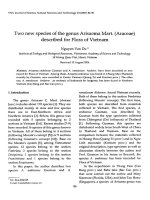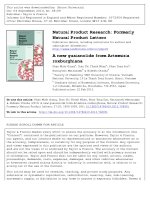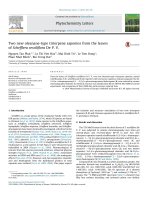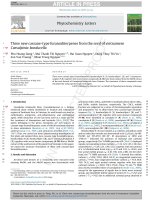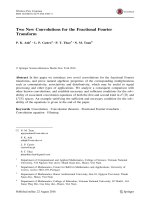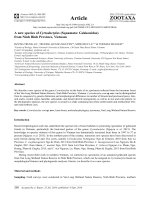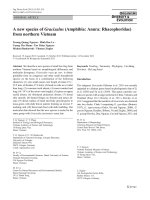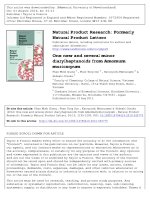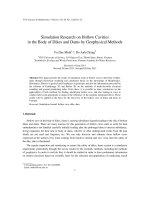DSpace at VNU: Two new oleanane-type triterpene saponins from the leaves of Schefflera sessiliflora De PV
Bạn đang xem bản rút gọn của tài liệu. Xem và tải ngay bản đầy đủ của tài liệu tại đây (303.48 KB, 4 trang )
Phytochemistry Letters 11 (2015) 102–105
Contents lists available at ScienceDirect
Phytochemistry Letters
journal homepage: www.elsevier.com/locate/phytol
Two new oleanane-type triterpene saponins from the leaves
of Schefflera sessiliflora De P. V.
Nguyen Tan Phat a,*, Le Thi Viet Hoa b, Mai Dinh Tri a, Le Tien Dung a,
Phan Nhat Minh a, Bui Trong Dat a
a
b
Institute of Chemical Technology, Vietnam Academy of Science and Technology, Ho Chi Minh City, Viet Nam
University of Technology, Vietnam National University, Ho Chi Minh City, Viet Nam
A R T I C L E I N F O
A B S T R A C T
Article history:
Received 30 September 2014
Received in revised form 20 November 2014
Accepted 27 November 2014
Available online 9 December 2014
From the leaves of Schefflera sessiliflora De P. V., two new oleanane-type triterpene saponins, named
scheffleraside A (1), scheffleraside B (2); together with two known saponins, chikusetsusaponin IVa (3),
3-O-[a-L-rhamnopyranosyl-(1 ! 3)]-b-D-glucuronopyranosyl hederagenin (4) were isolated by various
chromatography methods. Its chemical structure was elucidated by IR, UV, HR-ESI-MS, NMR 1D and 2D
experiments and comparison of their NMR data with previous reported data.
ß 2014 Phytochemical Society of Europe. Published by Elsevier B.V. All rights reserved.
Keywords:
Schefflera sessiliflora De P. V.
Araliaceae
Scheffleraside A
Scheffleraside B
1. Introduction
Schefflera is a large genus of the Araliaceae family with over
650 species (Hebbar and Nalini, 2014), which 56 species are found
in Vietnam (La et al., 2013). Some species in the Schefflera genus,
such as Schefflera actinophylla, Schefflera arboricola, Schefflera
heptaphylla, Schefflera impressa, Schefflera leucantha, and Schefflerakwangsiensis have been chemically investigated, which led to the
isolation of triterpenoid (Wanas et al., 2010; Zhao et al., 2010; Wu
et al., 2013; Srivastava, 1992; Pancharoen et al., 1994; Wang et al.,
2014), sterol (Hansen and Boll, 1986), polyacetylene (Hansen and
Boll, 1986), phenolic (Li et al., 2005), antraquinone (Srivastava,
1992), trisaccharide (Tran et al., 1991). Schefflera sessiliflora De P. V.
(Araliaceae) is a new species in Viet Nam, it were discovered and
indentified in 2004 (Nguyen et al., 2004). Pharmacological of
extracts from this species possessed antistress, enhanced physical
strength (Nguyen et al., 2004; Huynh et al., 2005); antioxidant
activities in DPPH and MDA test (Vo et al., 2008); the androgenic
effects (Tran et al., 2012). However, only two sapogenins: oleanolic
acid and hederagenin from the hydrolyzed product of total
saponins were isolated (Vo et al., 2003, 2004). This paper reports
* Corresponding author. Tel.: +84 916 360 751; fax: +84 838293889.
E-mail addresses: ,
(N.T. Phat).
the isolation and structure elucidation of two new triterpene
saponins (1, 2) and 2 known saponins (3, 4) from S. sessiliflora De P.
V. growing in Vietnam.
2. Results and discussion
The 75% MeOH extract from the dried leaves of S. sessiliflora De
P. V. was subjected to column chromatography over silica gel
normal-phase and reversed-phase RP-18 to give two new
triterpene saponins named scheffleraside A (3-O-[a-L-rhamnopyranosyl-( 1! 3)]-b-D-glucuronopyranosyl oleanolic acid 28-O-[a-Lrhamnopyranosyl-(1 ! 4)]-b-D-glucopyranosyl ester) (1) and
scheffleraside B (3-O-[a-L-rhamnopyranosyl-(1 ! 3)]-b-D-(60 -Omethyl)glucuronopyranosyl oleanolic acid 28-O-[a-L-rhamnopyranosyl-(1 ! 4)]-b-D-glucopyranosyl ester) (2), and two known
saponins: 3-O-b-D-glucuronopyranosyl oleanolic acid 28-O-b-Dglucopyranosyl ester (chikusetsusaponin IVa) (4) (Mizui et al.,
1990), 3-O-[a-L-rhamnopyranosyl-(1 ! 3)]-b-D-glucuronopyranosyl hederagenin (5) (El and Morta, 1998).
Compound (1) was obtained as a white amorphous powder. The
molecular formula was established as C54H86O22 by HR-ESI-MS
data ([MÀH]À m/z: 1085.5521, calcd. 1085.5527 and [M+Na]+ m/z
1109.5533, calcd. 1109.5503). The IR spectrum of 1 showed
absorptions of hydroxyl (3418 cmÀ1) and carbonyl (1726 cmÀ1)
groups. The 13C NMR and DEPT spectrum (Table 1), showed 1 has
fifty four carbons including: one carbonyl carbon, two olefinic
/>1874-3900/ß 2014 Phytochemical Society of Europe. Published by Elsevier B.V. All rights reserved.
N.T. Phat et al. / Phytochemistry Letters 11 (2015) 102–105
Table 1
1
H (500 Hz) and
Aglycone
1
2
3
4
5
6
7
8
9
10
11
12
13
14
15
16
17
18
19
20
21
22
23
24
25
26
27
28
29
30
a
103
13
C (125 Hz) NMR spectral data for compounds 1 and 2 in pyridine-d5.
1
2
Sugar
dH
dC
dH
dC
0.77, 1.30
1.74, 2.24
3.26 br d (7.5)
–
0.69
1.21, 1.40
1.30, 1.40
–
1.53
–
1.81
5.38 br s
–
–
1.14, 1.30
1.89, 2.05
–
3.14 br d (10.0)
1.21, 1.74
–
1.03, 1.30
1.68, 1.74
1.21 s
0.92 s
0.77 s
1.03 s
1.24 s
–
0.89 s
0.86 s
38.6
26.4
89.1
39.4
55.6
18.4
33.1
39.8
47.9
36.8
23.7
122.9
144.1
42.0
28.2
23.3
47.0
41.7
46.1
30.7
34.0
32.5
28.1
16.9
15.4
17.4
26.0
176.4
33.1
23.6
0.78, 1.28
1.72, 2.04
3.26 dd (4.0, 11.5)
–
0.72
1.20, 1.41
1.28, 1.41
–
1.56
–
1.83
5.38 br s
–
–
1.14, 1.26
1.90, 2.04
–
3.16 br d (13.0)
1.20, 1.72
–
1.04, 1.28
1.72, 1.72
1.21 s
0.91 s
0.78 s
1.04 s
1.24 s
–
0.90 s
0.87 s
38.6
26.4
89.3
39.5
55.7
18.4
33.1
39.9
48.0
36.9
23.7
122.9
144.1
42.1
28.2
23.3
47.0
41.7
46.1
30.7
34.0
32.5
28.0
16.8
15.5
17.4
26.1
176.4
33.1
23.6
GlcA
10
20
30
40
50
60
60 -OMe
Rha I
100
200
300
400
500
600
Glc-28
10 00
20 00
30 00
40 00
50 00
60 00
Rha II
100 00
200 00
300 00
400 00
500 00
600 00
1
2
dH
dC
dH
dC
4.78 d (6.5)
4.00
4.37
4.28
4.37
106.8
75.9
82.1
72.0
76.9
4.86 d (7.5)
4.03
4.39
4.39
4.48
3.76 s
107.0
75.7
82.0
71.4
77.1
170.7
52.1
d (5.0)
102.5
72.5
72.6
74.1
69.6
18.6
6.28 br s
4.73 d (1.5)
4.54
4.32
5.06
1.68 d (6.5)
102.9
72.5
72.7
74.1
69.8
18.6
6.18 d (8.0)
4.10
4.18
4.47
3.76 d (9.5)
4.04, 4.18
95.3
74.2
77.0
77.8
77.8
60.9
6.20 d (8.0)
4.12
4.20
4.52
3.78 d (9.5)
4.05, 4.20
95.4
74.2
77.1
77.9
77.9
61.0
5.85 br s
4.63 br s
4.47
4.28
4.86
1.65 d (6.0)
102.6
72.5
72.7
73.8
70.3
18.4
5.87 br s
4.64 d (1.5)
4.52
4.32
4.90
1.66 d (6.5)
102.7
72.5
72.7
73.9
70.4
18.5
a
6.28
4.71
4.56
4.28
5.06
1.68
br s
br s
d (8.0)
Not determined.
carbons, four anomeric carbons, seventeen oxygenated methine
carbons, one oxygenated methylene carbon, six quaternary
carbons, three methine carbons, ten methylene carbons, and nine
methyl carbons. The presence of seven tertiary methyl groups, two
olefinic carbons at dC 144.0 (C-13) and 122.8 (C-12), and one
carbonyl carbon 176.4 (C-28) which indicated an olean-12-en-28oic acid as an aglycone (Tran et al., 1991). Thus 1 was an oleananetype triterpenoid saponin bearing four sugar (six carbons) units.
The 1H NMR data (Table 1) also indicated aglycone of 1 was
oleanolic acid with: one olefinic proton at dH 5.38 (br s, H-12); one
oxygenated methine proton at dH 3.26 (br d, 7.5, H-3); one methine
proton at dH 3.14 (br d, 10.0, H-18) and seven tertiary methyl
groups at dH 0.76–1.24 (Maeda et al., 1994). Moreover, four
anomeric protons at dH 4.78 (d, 6.5, H-10 ); 6.18 (d, 8.0, H-1000 ); 6.28
(br s, H-100 ); 5.85 (br s H-10000 ) to four anomeric carbons at dC 106.8
(C-10 ), 95.3 (C-1000 ), 102.5 (C-100 ), 102.6 (C-10000 ) were assigned to bD-glucuronic (GlcA), b-D-glucose (Glc) and two a-L-rhamnose (Rha)
units, respectively. It was completely appropriated with HR-ESIMS data, a peak [M+2NaÀH]+ m/z 1131.5492 was indicated the
presence of a sugar acid (Madl et al., 2006). The COSY, HSQC and
NOESY spectrum, allowed analysis of their spin systems and
assigned of their proton resonances to determine clearly every
sugar unit. Beside, through acid hydrolysis followed by co-TLC in
comparison with standard sugars the identification of the sugars
was determined to be D for Glc, GlcA and L for Rha (see Section 3).
The HMBC spectrum (Fig. 1), showed correlations between
anomeric proton at dH 4.78 (d, 6.5, H-10 ) of GlcA and carbons at
dC 89.1 (C-3) of aglycone; between anomeric proton at dH 6.28 (br s,
H-100 ) of Rha I unit and carbons at dC 82.1 (C-30 ) of GlcA; between
oxygenated methine proton at dH 4.37 (m, H-30 ) and carbon acetal
at dC 102.5 (C-100 ). On the other hands, anomeric proton at dH 6.18
(d, 8.0, H-1000 ) of Glc correlated with carbonyl carbon at dC 176.4 (C28); anomeric proton at dH 5.85 (br s, H-10000 ) of Rha II correlated
with carbon at dC 77.8 (C-4000 ) of Glc; between oxygenated methine
proton at dH 4.47 (m, H-4000 ) and carbon acetal at dC 102.6 (C-10000 ).
These connectivities were also confirmed by correlations observed
in the NOESY spectrum between H-3 (dH 3.26) of aglycone and H-10
(dH 4.78) of GlcA; between H-100 (dH 6.28) of RhaI and H-30 (dH 4.37)
of GlcA. Based on data of HR-ESI-MS, 1D, 2D-NMR and compared
with previous published data (Tapondjou et al., 2006; Wang et al.,
2014), the structure of 1 was identified as 3-O-[a-L-rhamnopyranosyl-(1 ! 3)]-b-D-glucuronopyranosyl oleanolic acid 28-O-[a-Lrhamnopyranosyl-(1 ! 4)]-b-D-glucopyranosyl ester, and named
scheffleraside A.
Compound (2) was obtained as a white amorphous powder. The
molecular formula was established as C55H88O22 by HR-ESI-MS data
([M+Na]+ m/z 1123.5633, calcd. 1123.5659). The 1H and 13C NMR
data (Table 1) demonstrated that 2 has the same aglycone and sugar
chains as 1, except for presence of an oxygenated methyl group [dH
3.76 (s); dC 52.1]. Further, the HMBC spectrum (Fig. 1) showed
correlation between this oxygenated methyl at dH 3.76 (s) and carbon
carbonyl of glucuronic unit at dC 170.7. Based on data of HR-ESI-MS,
1D, 2D-NMR and compared with previous published data (Tapondjou et al., 2006; Wang et al., 2014), the structure of 2 was identified as
3-O-[a-L-rhamnopyranosyl-(1 ! 3)]-b-D-(60 -O-methyl)glucuronopyranosyl oleanolic acid 28-O-[a-L-rhamnopyranosyl-(1 ! 4)]-b-Dglucopyranosyl ester, and named scheffleraside B.
Some species in the Schefflera genus, such as S. actinophylla
(Wanas et al., 2010), S. arboricola (Zhao et al., 2010), S. impressa
(Srivastava, 1992), S. leucantha (Pancharoen et al., 1994) are
reported as a rich source of saponins which possessed lupane-type
and/or ursane-type aglycones. Whereas, the genins of S. heptaphylla (Maeda et al., 1994), S. kwangsiensis (Wang et al., 2014) as
well as S. sessiliflora were oleanolic acid and hederagenin. However,
all compounds were isolated for the first time from the genus
Schefflera.
N.T. Phat et al. / Phytochemistry Letters 11 (2015) 102–105
104
Fig. 1. Chemical structures and selected HMBC, COSY and NOESY correlations of 1 and 2.
3. Experimental
3.1. General experimental procedures
The high resolution electrospray ionization mass spectroscopy
(HR-ESI-MS) was recorded on a Bruker MicrOTOF-QII spectrometer. The 1H NMR (500 MHz), 13C NMR (125 MHz), DEPT, COSY,
HSQC and HMBC spectra were recorded on a Bruker AM500 FTNMR spectrometer using tetramethylsilane (TMS) as internal
standard. Column chromatography was carried out using Merck
Silica gel normal-phase (230–240 mesh) and reversed-phase C18
(Merck). Analytical TLC was carried out in silica gel plates (Merck
DC-Alufolien 60 F254). Compounds were visualized by spraying
with aqueous 10% H2SO4 and heating for 3–5 min.
seven subfractions (IV.1–IV.7). Fraction IV.2 (15 g), was eluted with
solvent system CHCl3–MeOH–H2O (85:15:0.1 ! 75:25:0.3, v/v),
then, separated by RP-18 using gradient mixtures of MeOH–H2O
gave 3 (15 mg) and 4 (8 mg). Similar, Fraction IV.3 (20 g) was eluted
with solvent system CHCl3–MeOH–H2O (80:20:0.2 ! 70:30:0.5,
v/v), then, separated by RP-18 using gradient mixtures of MeOH–
H2O gave 1 (12 mg) and 2 (16 mg).
3.3.1. Scheffleraside A (1)
Amorphous powder (MeOH); ½a25
D À17.0 (c 0.10, MeOH); IR
(KBr) ymax: 3418, 2927, 1726, 1615, 1075, 1030 cmÀ1; UV (MeOH)
lmax: 206 and 220 nm; HR-ESI-MS m/z 1085.5521 [MÀH]À (calcd
for C54H85O22, 1085.5527) and m/z 1109.5533 [M+Na]+ (calcd for
C54H86O22Na, 1109.5503); 1H and 13C NMR data (pyridine-d5), see
Table 1.
3.2. Plant material
The leaves of S. sessiliflora De P. V. were provided by Center
Cultivation and Processing of Medicinal Plants Da Lat, No. 18 Hoang
Van Thu Street, Da Lat City, Viet Nam and identified by Dr. Phan
Van De – Department of Medicinal Resources, The Research Center
of Ginseng and Medicinal Materials, Ho Chi Minh City, Viet Nam. A
voucher specimen was deposited in Bioactive Compounds
Laboratory, Institute of Chemical Technology, Vietnam Academy
of Science and Technology, Viet Nam.
The leaves were collected, washed, dried, and powdered.
3.3. Extraction and isolation
Powder of leaves S. sessiliflora De P. V. (5 kg) were extracted with
96% EtOH (v/v), filtered residue, removed solvents under low
pressure, obtained crude extract (890 g). Then, crude extract was
added water and extracted with n-hexane, ethyl acetate, obtained
extracts respectively. The aqueous portion was eluted by Diaion HP20 column with: H2O, 25% MeOH, 50% MeOH, 75% MeOH and 100%
MeOH. Then distilled solvents, gave five major fractions (I–V),
respectively. Fraction IV (80 g) was subjected by column chromatography with mobile phase (EtOAc–MeOH) gradient (0–100%) gave
3.3.2. Scheffleraside B (2)
Amorphous powder (MeOH); ½a25
D À13.5 (c 0.10, MeOH); IR
(KBr) ymax: 3423, 2924, 1741, 1635, 1067, 1039 cmÀ1; UV (MeOH)
lmax: 240 nm; HR-ESI-MS m/z 1123.5633 [M+Na]+, calcd for
C58H88O22Na, 1123.5659; 1H and 13C NMR data (pyridine-d5), see
Table 1.
3.4. Acid hydrolysis
Each saponin (2 mg) was refluxed with 2 N aq. CH3COOH (5 ml)
for 2 h at 100 8C. After extraction with CH3Cl (3Â 5 ml), the aqueous
layer was repeatedly evaporated to dryness with MeOH until
neutral, and then analyzed by TLC over silica gel (MeCOEt–isoPrOH–
Me2CO–H2O 20:10:7:6) by comparison with authentic samples (Lrhamnose Rf 0.65; D-glucose Rf 0.40; D-glucuronic acid Rf 0.05)
(Haddad et al., 2013; Voutquenne-Nazabadioko et al., 2013).
References
Haddad, M., Lelamer, A.C., Banuls, L.M.Y., Vasquez, P., Carraz, M., Vaisberg, A.,
Castillo, D., Sauvain, M., Rojas, R., Kiss, R., 2013. In vitro growth inhibitory
effects of 13,28-epoxyoleanane triterpene saponins in cancer cells. Phytochem.
Lett. 6, 128–134.
N.T. Phat et al. / Phytochemistry Letters 11 (2015) 102–105
Hansen, L., Boll, P.M., 1986. The polyacetylenic falcarinol as the major allergen in
Schefflera arboricola. Phytochemistry 25, 529–530.
Hebbar, D.R., Nalini, M.S., 2014. Evaluation of phytochemicals, total phenolics and
antioxidant activities of Schefflera spp. (Araliaceae) from southern India. J.
Pharmacogn. Phytochem. 2, 10–14.
Huynh, N.T., Phan, K.L., Nguyen, P.D., Tran, C.L., 2005. Studies on the effects of
enhancing physical strength and antistress from the leaves of three Schefflera
species as well as their combinative effects with red ginseng on mice. J. Med.
Hochiminh City 9, 91–95.
La, D.M., Chau, V.M., Tran, V.S., Pham, Q.L., Phan, V.K., Tran, H.T., Tran, M.H., Ninh,
K.B., Le, M.H., 2013. Prospects of natural bioactive products from Araliaceae
Juss. Family in VietNam.In: The 5-th National Conference on Ecology and
Biological Resources. pp. 1152–1158.
Li, Y.L., But, P.P.H., Ooi, V.E.C., 2005. Antiviral activity and mode of action of caffeoylquinic acids from Schefflera heptaphylla (L.) Frodin. Antivir. Res. 68, 1–9.
Madl, T., Sterk, H., Mittelbach, M., 2006. Tandem mass spectrometric analysis of a
complex triterpene saponin mixture of Chenopodium quinoa. J. Am. Soc. Mass
Spectrom. 17, 795–806.
Maeda, C., Ohtani, K., Kasai, R., Yamasaki, K., Nguyen, M.D., Nguyen, T.N., Nguyen,
K.Q.C., 1994. Oleanane and ursane glycosides from Schefflera octophylla. Phytochemistry 37, 1131–1137.
Mizui, F., Kasai, R., Ohtani, K., Tanaka, O., 1990. Saponins from bran of quinoa,
Chenopodium quinoa Willd. II. Chem. Pharm. Bull. 38, 375–377.
EI, S., Morta, M., 1998. Study of the saponin content of Atriplex stylosa VIV, and its
molluscicidal effect. Bull. Pharm. Sci. Assiut Univ. 21, 237–243.
Nguyen, T.T.H., Nguyen, T.C., Do, M.A., Tran, C.L., Nguyen, P.D., 2004. Studies on the
combinative effects of the leaves of three Schefflera species (Araliaceae) with red
ginseng on the effects of enhancing physical strength and antistress. J. Med.
Hochiminh City 8, 151–155.
Pancharoen, O., Tuniwachwuttikul, P., Taylor, W.C., Picker, K., 1994. Triterpenoid
glycosides from Schefflera leucantha. Phytochemistry 35, 987–992.
105
Srivastava, S.K., 1992. A new triterpenic acid from Schefflera impressa. J. Nat. Prod.
55, 298–302.
Tapondjou, A.L., Miyamoto, T., Lacaille-Dubois, M.A., 2006. Glucuronide triterpene
saponins from Bersama engleriana. Phytochemistry 67, 2126–2132.
Tran, V.S., Peter-Katalinic, J., Gu¨nter, A., 1991. A bidesmosidic triterpenoid saponin
from Schefflera octaphylla. Phytochemistry 30, 3717–3720.
Tran, M.T., Dang, T.T.N., Tran, C.L., Nguyen, T.T.H., 2012. Study on androgenic effect
of Schefflera sp3. J. Med. Mater.: Hanoi 17, 17–23.
Vo, D.H., Tran, C.L., Duong, H.T.Q., 2003. Survey characteristics and preliminary
study of the chemical composition of leaves, stems and roots of Schefflera sp3. J.
Med. Mater.: Hanoi 6, 161–167.
Vo, D.H., Tran, C.L., Duong, H.T.Q., 2004. Studies on saponin composition of Schefflera
sp3. J. Med. Mater.: Hanoi 9, 46–50.
Vo, D.H., Nguyen, T.T.H., Tran, C.L., Huynh, T.C.H., 2008. Study on the chemistry and
in vitro antioxidant activity of saponin from Schefflera sp3. J. Med. Mater.: Hanoi
13, 17–21.
Voutquenne-Nazabadioko, L., Gevrenova, R., Borie, N., Harakat, D., Sayagh, C., Weng,
A., Thakur, M., Zaharieva, M., Henry, M., 2013. Triterpenoid saponins from the
roots of Gypsophila trichotoma Wender. Phytochemistry 90, 114–127.
Wanas, A.S., Matsunami, K., Otsuka, H., Desoukey, S.Y., Fouad, M.A., Kamel, M.S.,
2010. Triterpene glycosides and glucosyl esters, and a triterpene from the leaves
of Schafera actinophylla. Chem. Pharm. Bull. 58, 1596–1601.
Wang, Y., Wang, L., Wang, W.J., Zhang, X.Q., Tian, H.Y., Zhang, Q.W., Li, Y.L., Ye, W.C.,
2014. New triterpenoid saponins from the aerial parts of Schefflera kwangsiensis.
Carbohydr. Res. 385, 65–71.
Wu, C., Duan, Y.H., Li, M.M., Tang, W., Wu, X., Wang, G.C., Ye, W.C., Zhou, G.X., Li, Y.L.,
2013. Triterpenoid saponins from the stem barks of Schefflera heptaphylla.
Planta Med. 79, 1348–1355.
Zhao, Z., Matsunami, K., Otsuka, H., Shinzato, T., Takeda, Y., Kawahata, M., Yamaguchi, K., 2010. Schefflerins A-G, new triterpene glucosides from the leaves of
Schefflera arboricola. Chem. Pharm. Bull. 58, 1343–1348.
